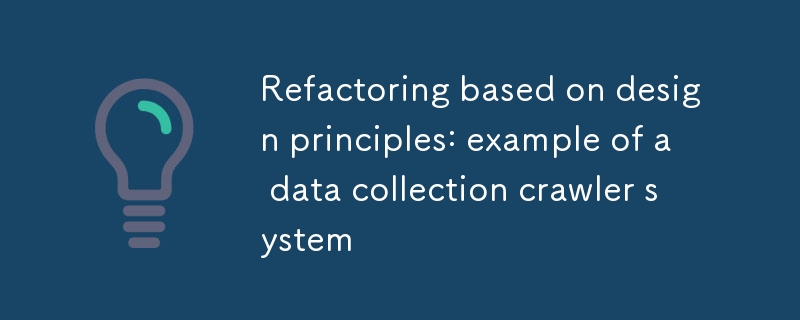
提高程式碼品質始終是軟體開發中的重要議題。在本文中,我們以資料收集爬蟲系統為例,具體講解如何透過逐步重建來應用設計原則和最佳實務。
首先,我們從一個非常簡單的網頁抓取工具開始,將所有功能整合到一個類別中。
由 DeepL.com 翻譯(免費版)
project_root/ ├── web_scraper.py ├── main.py └── requirements.txt
web_scraper.py
import requests
import json
import sqlite3
class WebScraper:
def __init__(self, url):
self.url = url
def fetch_data(self):
response = requests.get(self.url)
data = response.text
parsed_data = self.parse_data(data)
enriched_data = self.enrich_data(parsed_data)
self.save_data(enriched_data)
return enriched_data
def parse_data(self, data):
return json.loads(data)
def enrich_data(self, data):
# Apply business logic here
# Example: extract only data containing specific keywords
return {k: v for k, v in data.items() if 'important' in v.lower()}
def save_data(self, data):
conn = sqlite3.connect('test.db')
cursor = conn.cursor()
cursor.execute('INSERT INTO data (json_data) VALUES (?)', (json.dumps(data),))
conn.commit()
conn.close()
main.py
from web_scraper import WebScraper
def main():
scraper = WebScraper('https://example.com/api/data')
data = scraper.fetch_data()
print(data)
if __name__ == "__main__":
main()
目錄結構
project_root/ ├── data_fetcher.py ├── data_parser.py ├── data_saver.py ├── data_enricher.py ├── web_scraper.py ├── main.py └── requirements.txt
data_enricher.py
class DataEnricher:
def enrich(self, data):
return {k: v for k, v in data.items() if 'important' in v.lower()}
web_scraper.py
from data_fetcher import DataFetcher
from data_parser import DataParser
from data_enricher import DataEnricher
from data_saver import DataSaver
class WebScraper:
def __init__(self, url):
self.url = url
self.fetcher = DataFetcher()
self.parser = DataParser()
self.enricher = DataEnricher()
self.saver = DataSaver()
def fetch_data(self):
raw_data = self.fetcher.fetch(self.url)
parsed_data = self.parser.parse(raw_data)
enriched_data = self.enricher.enrich(parsed_data)
self.saver.save(enriched_data)
return enriched_data
此變更明確了每個類別的職責並提高了可重複使用性和可測試性。然而,業務邏輯仍然嵌入在 DataEnricher 類別中。
目錄結構
project_root/ ├── interfaces/ │ ├── __init__.py │ ├── data_fetcher_interface.py │ ├── data_parser_interface.py │ ├── data_enricher_interface.py │ └── data_saver_interface.py ├── implementations/ │ ├── __init__.py │ ├── http_data_fetcher.py │ ├── json_data_parser.py │ ├── keyword_data_enricher.py │ └── sqlite_data_saver.py ├── web_scraper.py ├── main.py └── requirements.txt
介面/data_fetcher_interface.py
from abc import ABC, abstractmethod
class DataFetcherInterface(ABC):
@abstractmethod
def fetch(self, url: str) -> str:
pass
介面/data_parser_interface.py
from abc import ABC, abstractmethod
from typing import Dict, Any
class DataParserInterface(ABC):
@abstractmethod
def parse(self, raw_data: str) -> Dict[str, Any]:
pass
介面/data_enricher_interface.py
from abc import ABC, abstractmethod
from typing import Dict, Any
class DataEnricherInterface(ABC):
@abstractmethod
def enrich(self, data: Dict[str, Any]) -> Dict[str, Any]:
pass
介面/data_saver_interface.py
from abc import ABC, abstractmethod
from typing import Dict, Any
class DataSaverInterface(ABC):
@abstractmethod
def save(self, data: Dict[str, Any]) -> None:
pass
實作/keyword_data_enricher.py
import os
from interfaces.data_enricher_interface import DataEnricherInterface
class KeywordDataEnricher(DataEnricherInterface):
def __init__(self):
self.keyword = os.getenv('IMPORTANT_KEYWORD', 'important')
def enrich(self, data):
return {k: v for k, v in data.items() if self.keyword in str(v).lower()}
web_scraper.py
from interfaces.data_fetcher_interface import DataFetcherInterface
from interfaces.data_parser_interface import DataParserInterface
from interfaces.data_enricher_interface import DataEnricherInterface
from interfaces.data_saver_interface import DataSaverInterface
class WebScraper:
def __init__(self, fetcher: DataFetcherInterface, parser: DataParserInterface,
enricher: DataEnricherInterface, saver: DataSaverInterface):
self.fetcher = fetcher
self.parser = parser
self.enricher = enricher
self.saver = saver
def fetch_data(self, url):
raw_data = self.fetcher.fetch(url)
parsed_data = self.parser.parse(raw_data)
enriched_data = self.enricher.enrich(parsed_data)
self.saver.save(enriched_data)
return enriched_data
現階段主要變化有
這些改變大大提高了系統的靈活性和可擴展性。然而,業務邏輯仍然嵌入在 DataEnricherInterface 及其實作中。下一步就是進一步分離這個業務邏輯,並明確定義為領域層。
上一步中,介面的引入增加了系統的彈性。但是,業務邏輯(在本例中為資料重要性確定和過濾)仍然被視為資料層的一部分。基於領域驅動設計的理念,將此業務邏輯視為系統的中心概念,並將其實現為獨立的領域層,可以帶來以下好處
更新的目錄結構:
project_root/ ├── domain/ │ ├── __init__.py │ ├── scraped_data.py │ └── data_enrichment_service.py ├── data/ │ ├── __init__.py │ ├── interfaces/ │ │ ├── __init__.py │ │ ├── data_fetcher_interface.py │ │ ├── data_parser_interface.py │ │ └── data_saver_interface.py │ ├── implementations/ │ │ ├── __init__.py │ │ ├── http_data_fetcher.py │ │ ├── json_data_parser.py │ │ └── sqlite_data_saver.py ├── application/ │ ├── __init__.py │ └── web_scraper.py ├── main.py └── requirements.txt
現階段,DataEnricherInterface 和 KeywordDataEnricher 的角色將轉移到領域層的 ScrapedData 模型和 DataEnrichmentService 中。下面提供了此更改的詳細資訊。
更改前(第 2 部分)
class DataEnricherInterface(ABC):
@abstractmethod
def enrich(self, data: Dict[str, Any]) -> Dict[str, Any]:
pass
class KeywordDataEnricher(DataEnricherInterface):
def __init__(self):
self.keyword = os.getenv('IMPORTANT_KEYWORD', 'important')
def enrich(self, data):
return {k: v for k, v in data.items() if self.keyword in str(v).lower()}
修改後(第 3 部分)
@dataclass
class ScrapedData:
content: Dict[str, Any]
source_url: str
def is_important(self) -> bool:
important_keyword = os.getenv('IMPORTANT_KEYWORD', 'important')
return any(important_keyword in str(v).lower() for v in self.content.values())
class DataEnrichmentService:
def __init__(self):
self.important_keyword = os.getenv('IMPORTANT_KEYWORD', 'important')
def enrich(self, data: ScrapedData) -> ScrapedData:
if data.is_important():
enriched_content = {k: v for k, v in data.content.items() if self.important_keyword in str(v).lower()}
return ScrapedData(content=enriched_content, source_url=data.source_url)
return data
此變更改進了以下內容。
業務邏輯已移至網域層,消除了對 DataEnricherInterface 的需求。
the KeywordDataEnricher functionality has been merged into the DataEnrichmentService, centralizing the business logic in one place.
The is_important method has been added to the ScrapedData model. This makes the domain model itself responsible for determining the importance of data and makes the domain concept clearer.
DataEnrichmentService now handles ScrapedData objects directly, improving type safety.
The WebScraper class will also be updated to reflect this change.
from data.interfaces.data_fetcher_interface import DataFetcherInterface
from data.interfaces.data_parser_interface import DataParserInterface
from data.interfaces.data_saver_interface import DataSaverInterface
from domain.scraped_data import ScrapedData
from domain.data_enrichment_service import DataEnrichmentService
class WebScraper:
def __init__(self, fetcher: DataFetcherInterface, parser: DataParserInterface,
saver: DataSaverInterface, enrichment_service: DataEnrichmentService):
self.fetcher = fetcher
self.parser = parser
self.saver = saver
self.enrichment_service = enrichment_service
def fetch_data(self, url: str) -> ScrapedData:
raw_data = self.fetcher.fetch(url)
parsed_data = self.parser.parse(raw_data)
scraped_data = ScrapedData(content=parsed_data, source_url=url)
enriched_data = self.enrichment_service.enrich(scraped_data)
self.saver.save(enriched_data)
return enriched_data
This change completely shifts the business logic from the data layer to the domain layer, giving the system a clearer structure. The removal of the DataEnricherInterface and the introduction of the DataEnrichmentService are not just interface replacements, but fundamental changes in the way business logic is handled.
This article has demonstrated how to improve code quality and apply design principles specifically through a step-by-step refactoring process for the data collection crawler system. The main areas of improvement are as follows.
These improvements have greatly enhanced the system's modularity, reusability, testability, maintainability, and scalability. In particular, by applying some concepts of domain-driven design, the business logic became clearer and the structure was more flexible to accommodate future changes in requirements. At the same time, by maintaining the interfaces, we ensured the flexibility to easily change and extend the data layer implementation.
It is important to note that this refactoring process is not a one-time event, but part of a continuous improvement process. Depending on the size and complexity of the project, it is important to adopt design principles and DDD concepts at the appropriate level and to make incremental improvements.
Finally, the approach presented in this article can be applied to a wide variety of software projects, not just data collection crawlers. We encourage you to use them as a reference as you work to improve code quality and design.
以上是基於設計原則的重構:資料擷取爬蟲系統範例的詳細內容。更多資訊請關注PHP中文網其他相關文章!




